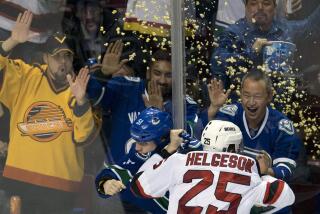Longevity Club Keeps Admitting Members
Not too long ago, it was considered a rarity for an athlete to play in 1,000 NHL games. Because of the brutality of the sport, few hockey players reached this milestone.
Thatâs not the case any more.
Already this season, 13 players have joined the 176-member 1,000-game club, and thereâs a chance two more will do so before the playoffs begin next month.
The Kingsâ Kelly Buchberger, Nashvilleâs Cliff Ronning, Phoenixâs Teppo Numminen, Pittsburghâs Stephane Richer, Dallasâ Joe Nieuwendyk, Tampa Bayâs Grant Ledyard, San Joseâs Adam Graves, Calgaryâs Dave Lowry, the New York Rangersâ Theo Fleury and Brian Leetch and Coloradoâs Mike Keane, Todd Gill and Joe Sakic have achieved this mark since October.
Philadelphiaâs Mark Recchi (994 as of Sunday) and Calgaryâs Craig Berube (982) are on pace to join them before the regular season ends next month with Philadelphiaâs Jeremy Roenick (971) leading a pack of others primed to reach the mark next season.
And the funny thing about most of these so-called âold-timersâ is that none seem prepared to quit soon.
âIf you look at athletics in general, athletes are producing at an older age in all sports,â said Washington center Adam Oates, who will turn 40 in August and leads the league in assists this season.
â[Compared to] when I came into this league ... guys really treat this sport differently. It is more of a 12-month sport and guys train a lot differently, and myself included. I train 10 times harder now than I used to when I first came into this league. And I think for the most part ... everybody does.â
After playing in his 1,000th game earlier this season, Buchberger said heâs part of a generation of players who simply enjoy playing hockey. He should know because when he played for Moose Jaw as a junior from 1984 to â86, two of his minor league teammates were Fleury and Keane.
Staying physically sound enough has also been a key. Players are able to bounce back from injuries thanks to improved medical technology and better all-around conditioning.
âI think playing the games is the easy part because we all love to play them,â said Oates, who has played in 1,192 games. âThe hard part is the training in the summer. The off-season conditioning is actually the hard part every year. Knowing that you have got to force yourself to get there and stay in condition.â
Size Doesnât Matter
One of the most unlikely players to play in 1,000 games is the 5-foot-8, 165-pound Ronning, who joined Sakic to become the latest players to reach the mark Saturday.
Despite his lack of size, Ronning has been regarded as one of the leagueâs toughest players for years. Heâs the Predatorsâ all-time leader in goals (80), assists (144), points (224), power-play goals (24), power-play points (95) and shots (877).
âHe was my roommate for three years in Phoenix and probably one of the true freaks of nature that there are in sports today,â Roenick said about Ronning. âHow you can have a guy who is 5-6, 5-7 or whatever he is and dominate a hockey game like he does?
âHeâs tremendously skilled. Heâs tremendously poised for being a little guy, and he is very, very, very smart in terms of knowing where to be and where the puck needs to be at the right time. Not to mention you canât catch him.â
Speeding Up the Game
Reaction around the league was mixed after general managers decided to approve further exploration of three on-ice rules at their annual March meeting.
âWe looked at a whole host of ways of moving the game along as quickly as we can,â Commissioner Gary Bettman said. âThere are three things that we came out of the meeting wanting to pursue. One is hurry-up line changes/faceoffs, one is not allowing a defending player to use his stick or his free hand in the neutral zone to obstruct an offensive player who is not carrying the puck, and the other was a modified âtag-upâ rule. We want to pursue implementation of all three elements, but to do that we have to make sure we define them in a way that works.â
The NHLâs hockey operations department will refine definitions of the âhurry-up faceoff,â the âtag-upâ offside rule and the standard of enforcement regarding obstruction, and then present the changes at a Board of Governors meeting in June.
Thatâs when the league will decide if any of the rules will be implemented for play next season.
âBefore we make changes, weâve got to be comfortable with [them],â San Jose General Manager Dean Lombardi said after last weekâs meetings. âI donât think thereâs a whole lot wrong with the game weâve got right now and you donât want to jump into anything.â
A big concern is that the league might try to make changes based on the success of the hockey competition at last monthâs Salt Lake City Winter Olympics.
âWe have to decide whether our goal is to get people out of the rink faster or are we trying to increase the flow of the game?â Lombardi said.
âWhat we have to do right now is look at the possibilities and then make an [informed] decision. We donât want to keep revisiting these issues.â
Line Shifts
* The odds of Calgary making a late run to qualify for the playoffs may be long, but the chances of Flame winger Jarome Iginla holding on to win the leagueâs scoring title have greatly improved since the Olympic break. With 16 games remaining in the regular season, Iginla has opened up some breathing room in the race for points and goals. Iginla, who will be a restricted free agent after this season, has said that he wants to remain in Calgary, but the Flames are expected to open negotiations at around $4 million per season. Word around the league has Iginla looking for a long-term deal worth at least $6 million annually.
* Edmonton is another Canadian team hoping to get hot down the stretch and Oiler General Manager Kevin Lowe is looking to make a deal before the leagueâs March 19 trading deadline. The Oilers have been offering Tom Poti as a trade candidate.
* Dallas owner Tom Hicks is known as someone not afraid to pay big money for a player (note: Texas Ranger shortstop Alex Rodriguez and his $25-million-a-year contract), but that doesnât mean heâs ready to make a deal for Floridaâs Pavel Bure and his $10-million-a-year contract.
As long as Pittsburgh General Manager Craig Patrick believes that the Penguins have a chance to make the playoffs, donât look for the team to trade Darius Kasparaitis or Robert Lang. But that could change, considering that both players will be unrestricted free agents this summer.
*
(BEGIN TEXT OF INFOBOX)
The Timesâ Rankings
(text of infobox not included)
More to Read
Go beyond the scoreboard
Get the latest on L.A.'s teams in the daily Sports Report newsletter.
You may occasionally receive promotional content from the Los Angeles Times.






